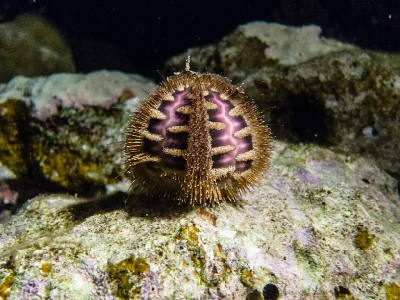Echinoidea
The sea urchin, Echinoidea, is a fascinating marine creature that can be found in oceans around the world. It belongs to the phylum Echinodermata, which also includes starfish and sea cucumbers. Sea urchins are known for their spherical or oval-shaped bodies, covered in spiny calcite plates that provide protection from predators.
Sea urchins come in various sizes, ranging from a few centimeters to several inches in diameter. Their spines, which are often sharp and barbed, can also come in different lengths and colors, depending on the species. These spines serve multiple purposes, including defense, locomotion, and sensing the environment.
The mouth of a sea urchin is located on its underside and is surrounded by rows of tube feet, which are used for movement and capturing food. Sea urchins are omnivorous, feeding on a wide range of food sources such as algae, dead organisms, and even small invertebrates. They use a specialized structure called Aristotle's lantern to scrape and chew their food.
Many sea urchin species inhabit shallow waters, where they can be found clinging to rocks, coral reefs, or hiding in crevices. However, some species are adapted to deeper oceanic environments, even reaching depths of several thousand meters. Sea urchins prefer colder waters, but can also adapt to warmer tropical regions.
Apart from their ecological significance as grazers and decomposers, sea urchins also play a vital role in maintaining the health of marine ecosystems. Some species have become pests in certain areas due to their overconsumption of kelp forests, leading to habitat degradation and loss of biodiversity. However, they are also important prey for many marine animals, such as otters, pufferfish, and some species of fish.
In addition to their ecological importance, sea urchins have garnered attention for their unique reproductive strategies. The fertilization in sea urchins takes place externally, with females releasing millions of eggs into the water, followed by males releasing sperm. The fertilized eggs develop into tiny larvae, which eventually settle on the ocean floor and transform into juvenile sea urchins.
Overall, sea urchins are fascinating creatures with a diversity of species and adaptations. Their spiny exterior, important ecological role, and intricate reproductive strategies make them a captivating subject of study and observation in the world's oceans.








